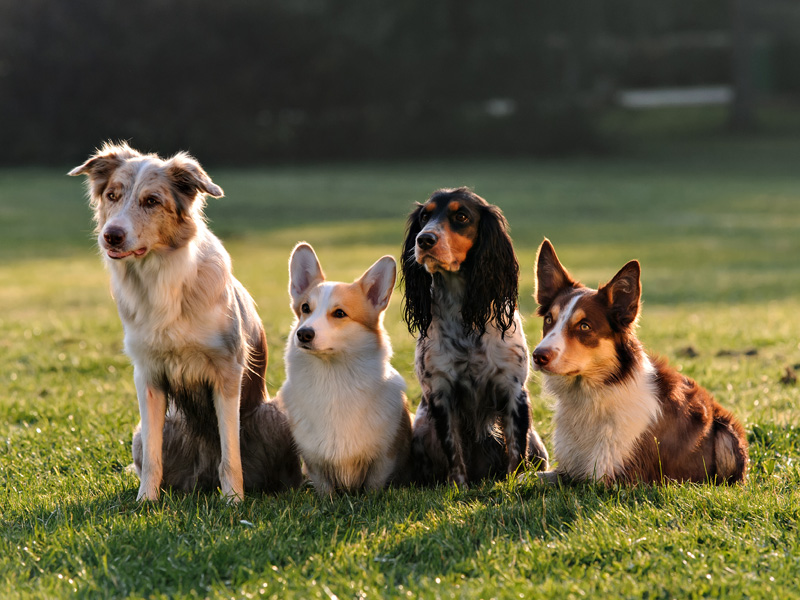|
|
From basic obedience commands to advanced tricks, dog training is a rewarding and engaging experience for you and your dog.
Just as every new human member of a household must be trained to behave properly, so must dogs. Everyone in the household is better off if the dog conforms to the behaviour expected of it.
That applies to the dog, too.
By nature, your dog wants your approval. It wants to please you (most of the time, anyway!). But it can’t do that without being taught what you expect of it.
During your dog’s life you may decide to teach it to perform all manner of impressive tricks and tasks. Those are optional. But the following types of training should be considered as absolutely essential for every dog owner.

TOILET TRAINING
If your dog spends any time indoors, toilet training is an absolute necessity – for very obvious reasons! Toilet training is often a time of trial and stress for everyone involved. But be patient, use the proper training techniques, and there’s sure to be a happy outcome.
Start when the dog is young – about 3 to 4 months of age. Any earlier, and your puppy probably won’t yet have sufficient bowel and bladder control. And if you start later, the training period is likely to take much longer.
When you begin the training, start by confining the puppy to a fairly restricted area – a single room, the length of a tethered lead, or even a crate. As your puppy begins to learn that ‘business’ is to be conducted outside, you can gradually expand the area that it’s allowed to roam.
Here are a few tips for effective toilet training:
- Regular mealtimes. Keep your puppy on a regular feeding schedule during toilet training. That means no snacking between meals! If it’s not mealtime, food shouldn’t be available to the dog.
- Offer frequent potty opportunities. Give your pup plenty of opportunities to take care of business outside. Go outside first thing in the morning, and then every 30 to 60 minutes throughout the day. And also take your puppy outside after it wakes from a nap or finishes a meal.
- Familiarity breeds comfort. Take your dog to the same spot outside every time. Your dog will recognize its scent and more readily do its business.
- Stay out with your dog. When you take your dog outside for a potty break, stay with it until it has taken care of business, or until it becomes obvious that it doesn’t need to just yet. Don’t just turn the dog out in the yard by itself.
- Praise success! When your doggie does its duty, praise it! Offer a treat, or something the dog really enjoys, like a walk.
OBEDIENCE TRAINING

Teaching your dog basic obedience is also a necessity. While an obedient dog is a pleasure to be around, the opposite is also true – a disobedient dog can be a real pain!
You can take your dog’s training to a much higher level if you choose to, of course. But at the very minimum, your dog should learn to respond to the following basic commands:
- Sit. This basic command helps you to keep control of your dog no matter the situation, and is a good command to teach first.
- Drop. This teaches your dog to instantly drop whatever is in its mouth. (Could save your dog from harm if it ever picks up something dangerous or toxic.)
- Stay. Teaches your dog to remain still, calm, and in one place.
- Heel. Teaches your dog to stay close to you as you walk, with or without a lead.
- Come. Teaches your dog to immediately come to you upon your command. You should begin to teach this command to your puppy as soon as it recognizes its name. This command could potentially help you protect your puppy from harm.
There are a number of dog-training methods available for teaching your dog these commands, but the Australian Veterinary Association recommends positive reinforcement as the bestmethod.
Positive reinforcement rewards wanted behaviour rather than punishing unwanted behaviour. This method of training makes learning more enjoyable for your dog, and will help to strengthen the bond between you and your pet.
START WITH THE BASICS
Teaching your dog the basic commands of obedience will make your household a much more pleasant place.
Your dog will be happy because it wants to please you, and because it wants to reap the rewards of good behaviour. You will be happier because your dog will be more manageable and will enrich your life.
And visitors will be happy not to have to endure a poorly behaved pooch rampaging through the house!


0 comments:
Post a Comment